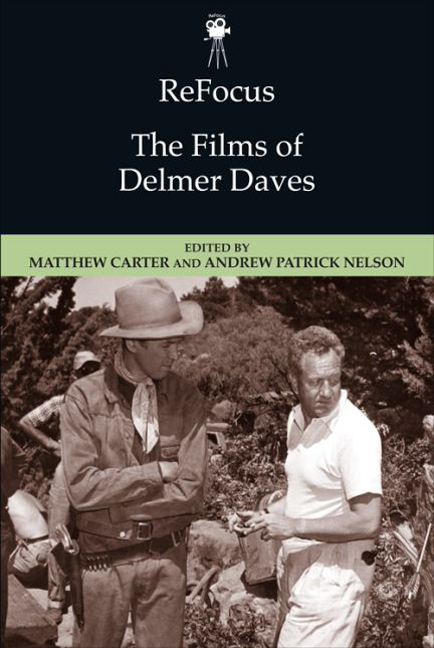Book contents
- Frontmatter
- Contents
- List of Figures
- Notes on Contributors
- Acknowledgments
- Introduction: “No One Would Know It Was Mine”: Delmer Daves, Modest Auteur
- 1 Don't Be Too Quick to Dismiss Them: Authorship and the Westerns of Delmer Daves
- 2 Trying to Ameliorate the System from Within: Delmer Daves’ Westerns from the 1950s
- 3 Bent, or Lifted Out by Its Roots: Daves' Broken Arrow and Drum Beat as Narratives of Conditional Sympathy
- 4 This Room is My Castle of Quiet: The Collaborations of Delmer Daves and Glenn Ford
- 5 Delmer Daves, Authenticity, and Auteur Elements: Celebrating the Ordinary in Cowboy
- 6 Home and the Range: Spencer's Mountain as Revisionist Family Melodrama
- 7 Delmer Daves’ 3:10 to Yuma: Aesthetics, Reception, and Cultural Significance
- 8 Changing Societies: The Red House, The Hanging Tree, Spencer's Mountain, and Post-war America
- 9 Partial Rehabilitation: Task Force and the Case of Billy Mitchell
- 10 “This Is Where He Brought Me: 10,000 Acres of Nothing!”: The Femme Fatale and other Film Noir Tropes in Delmer Daves’ Jubal
- Index
7 - Delmer Daves’ 3:10 to Yuma: Aesthetics, Reception, and Cultural Significance
Published online by Cambridge University Press: 15 September 2017
- Frontmatter
- Contents
- List of Figures
- Notes on Contributors
- Acknowledgments
- Introduction: “No One Would Know It Was Mine”: Delmer Daves, Modest Auteur
- 1 Don't Be Too Quick to Dismiss Them: Authorship and the Westerns of Delmer Daves
- 2 Trying to Ameliorate the System from Within: Delmer Daves’ Westerns from the 1950s
- 3 Bent, or Lifted Out by Its Roots: Daves' Broken Arrow and Drum Beat as Narratives of Conditional Sympathy
- 4 This Room is My Castle of Quiet: The Collaborations of Delmer Daves and Glenn Ford
- 5 Delmer Daves, Authenticity, and Auteur Elements: Celebrating the Ordinary in Cowboy
- 6 Home and the Range: Spencer's Mountain as Revisionist Family Melodrama
- 7 Delmer Daves’ 3:10 to Yuma: Aesthetics, Reception, and Cultural Significance
- 8 Changing Societies: The Red House, The Hanging Tree, Spencer's Mountain, and Post-war America
- 9 Partial Rehabilitation: Task Force and the Case of Billy Mitchell
- 10 “This Is Where He Brought Me: 10,000 Acres of Nothing!”: The Femme Fatale and other Film Noir Tropes in Delmer Daves’ Jubal
- Index
Summary
In 2012, the BAFTA-nominated film 3:10 to Yuma (1957) was selected by the Library of Congress for preservation. According to Librarian of Congress James Billington, this choice was made in light of its “enduring importance to American culture.” While Delmer Daves’ work has long been acclaimed for its direction and visuals, this more recent accolade, together with the release of a critically commended remake in 2007 (directed by James Mangold and starring Russell Crowe and Christian Bale), has rekindled scholarly interest in the earlier film. Much of this current research concentrates on the beleaguered masculinity of its protagonist, a theme not only relevant to the post-war contexts of the first production, but also appropriate to the post-9/11 zeitgeist of the remake. Consequently, several enquiries focus on a comparison between the two films, and their relationship to the original short story by Elmore Leonard on which they are based. Alternatively, psychoanalytic perspectives inform analysis whilst others adopt a generic approach, centering on Daves' Westerns as a discrete body of work. Contemporary analyses also emphasize the aesthetic qualities of Daves’ films, with Bertrand Tavernier designating some of his Westerns as “masterpieces.” Aside from their dramatic visual orchestration, the cultural significance of Daves’ Westerns lies in their realistic depiction of the harshness of frontier existence, offering a more historically accurate portrayal of life than is typically articulated by the Western. In addition, they present more progressive images of women than is usual for the genre, and also provide sympathetic and more authentic representations of Native Americans (as opposed to the stereotypical depictions that had hitherto populated the genre).
While there are indications that deviation from certain of these generic tropes caused negative responses to Daves’ Westerns in Britain, critical reception of 3:10 to Yuma at the time of its release is in fact consistently positive. Descriptions of it ranged from “very good” to “one of the most perfect small-scale works of the fifties” and, a decade later, as “the most perfect of Westerns.” James Powers labels it as “the best western since Gunfight at the OK Corral,” while an anonymous review in Film Daily describes the direction as “excellent” and photography as “fine” with reference to Charles Lawton's “atmospheric black and white photography,” and “competent performances” by cast members.
- Type
- Chapter
- Information
- ReFocus: The Films of Delmer Daves , pp. 149 - 165Publisher: Edinburgh University PressPrint publication year: 2016



